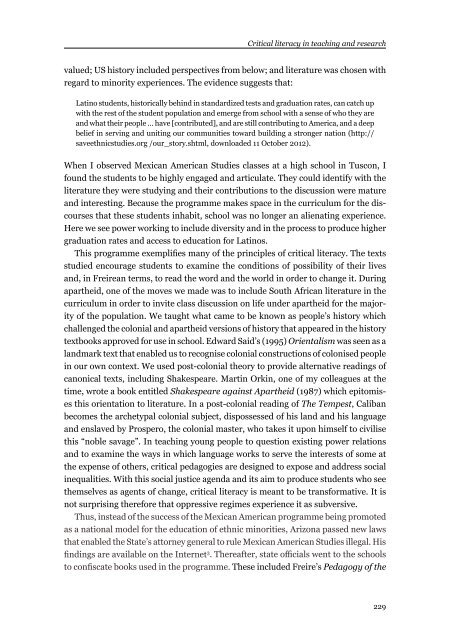Download issue - Umeå universitet
Download issue - Umeå universitet
Download issue - Umeå universitet
You also want an ePaper? Increase the reach of your titles
YUMPU automatically turns print PDFs into web optimized ePapers that Google loves.
Critical literacy in teaching and research<br />
valued; US history included perspectives from below; and literature was chosen with<br />
regard to minority experiences. The evidence suggests that:<br />
Latino students, historically behind in standardized tests and graduation rates, can catch up<br />
with the rest of the student population and emerge from school with a sense of who they are<br />
and what their people … have [contributed], and are still contributing to America, and a deep<br />
belief in serving and uniting our communities toward building a stronger nation (http://<br />
saveethnicstudies.org /our_story.shtml, downloaded 11 October 2012).<br />
When I observed Mexican American Studies classes at a high school in Tuscon, I<br />
found the students to be highly engaged and articulate. They could identify with the<br />
literature they were studying and their contributions to the discussion were mature<br />
and interesting. Because the programme makes space in the curriculum for the discourses<br />
that these students inhabit, school was no longer an alienating experience.<br />
Here we see power working to include diversity and in the process to produce higher<br />
graduation rates and access to education for Latinos.<br />
This programme exemplifies many of the principles of critical literacy. The texts<br />
studied encourage students to examine the conditions of possibility of their lives<br />
and, in Freirean terms, to read the word and the world in order to change it. During<br />
apartheid, one of the moves we made was to include South African literature in the<br />
curriculum in order to invite class discussion on life under apartheid for the majority<br />
of the population. We taught what came to be known as people’s history which<br />
challenged the colonial and apartheid versions of history that appeared in the history<br />
textbooks approved for use in school. Edward Said’s (1995) Orientalism was seen as a<br />
landmark text that enabled us to recognise colonial constructions of colonised people<br />
in our own context. We used post-colonial theory to provide alternative readings of<br />
canonical texts, including Shakespeare. Martin Orkin, one of my colleagues at the<br />
time, wrote a book entitled Shakespeare against Apartheid (1987) which epitomises<br />
this orientation to literature. In a post-colonial reading of The Tempest, Caliban<br />
becomes the archetypal colonial subject, dispossessed of his land and his language<br />
and enslaved by Prospero, the colonial master, who takes it upon himself to civilise<br />
this “noble savage”. In teaching young people to question existing power relations<br />
and to examine the ways in which language works to serve the interests of some at<br />
the expense of others, critical pedagogies are designed to expose and address social<br />
inequalities. With this social justice agenda and its aim to produce students who see<br />
themselves as agents of change, critical literacy is meant to be transformative. It is<br />
not surprising therefore that oppressive regimes experience it as subversive.<br />
Thus, instead of the success of the Mexican American programme being promoted<br />
as a national model for the education of ethnic minorities, Arizona passed new laws<br />
that enabled the State’s attorney general to rule Mexican American Studies illegal. His<br />
findings are available on the Internet 3 . Thereafter, state officials went to the schools<br />
to confiscate books used in the programme. These included Freire’s Pedagogy of the<br />
229

















